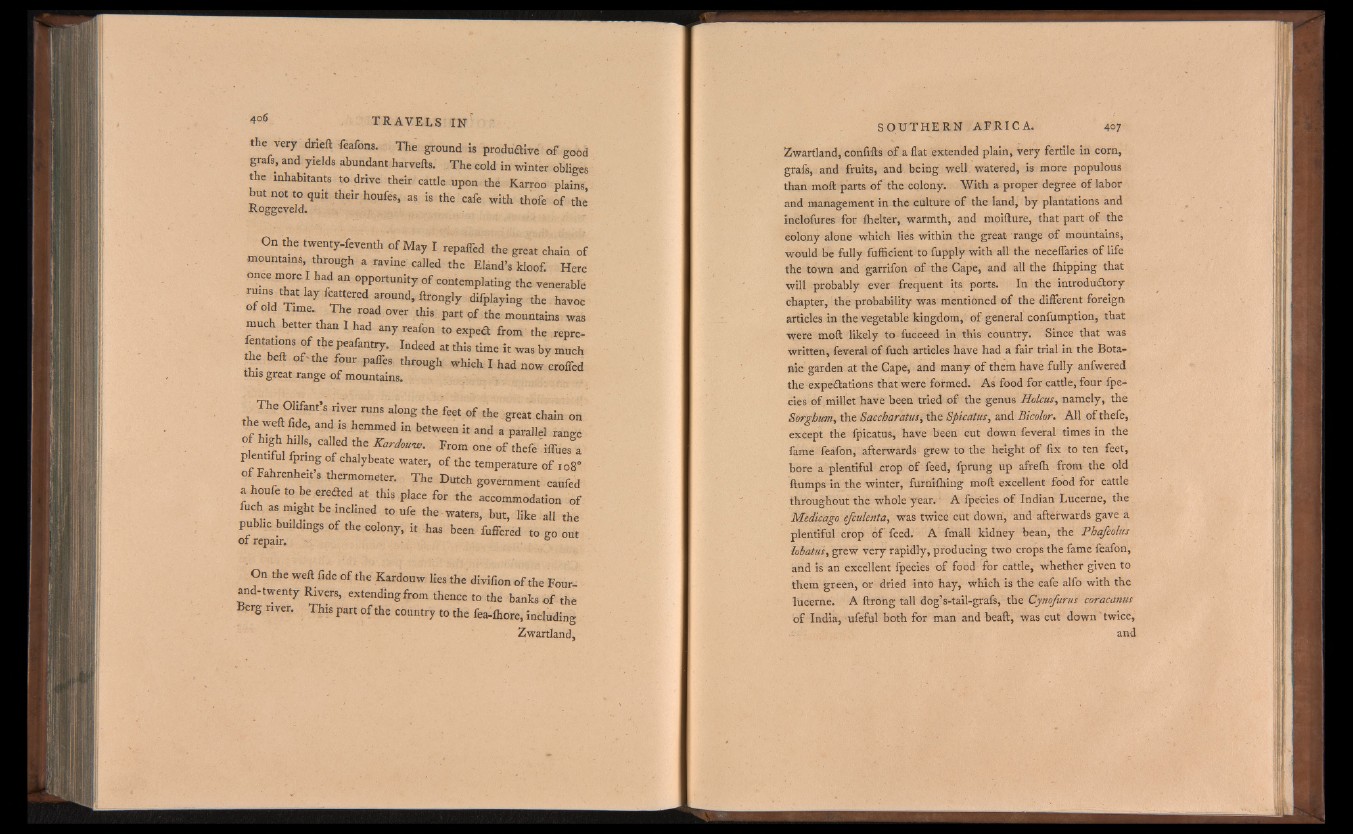
t e very drieft feafons. The ground Is produdive o f good
grafs, and yields abundant harvefts. The cold in winter obliges
the inhabitants to drive their cattle upon the Karroo plains,
but not to quit their houfes, as is the cafe with thofe o f the
Rogge veld.
On the twenty-feventh o f May I repaffed the great chain of
mountains, through a ravine called the Eland’s kloof. Here
once more I had an opportunity of contemplating the venerable
j n s that lay fcattered around, ftrongjy difplaying the havoc
, u Th7e road over part of the mountains was
much better than I had any reafon to expeCt from the representations
o f the peafantry. Indeed at this tíme it was by much
the belt o f' the four paffes through which I had now croifed
this great range of mountains.
The ° Y ant’s river runs alo«g the feet o f the great chain on
o / j f Í Í ’ “ i, 18 hemmed 5n betWee" h and 3 Parallel range
ugh hills, called the Kardouw. From one of thefe iffues a
plentiful fpnng of chalybeate water, of the temperature o f 108“
o f Fahrenheit’s thermometer. The Dutch government caufed
ahoufeto be ereCted at this place for the accommodation o f
fuch as might be inclined to ufe the waters, but, like all the
public buildings o f the colony, it has been fuffered to go out
o f repair. : °
On the weft fide of the Kardouw lies the divifion o f the Four
and-twenty Rivers, extending from thence to the banks o f the
Berg river. This part of the country to the fea-ihore, including
Zwartland,
Zwartland, confifts of a flat extended plain, very fertile in corn,
grafs, and fruits, and being well watered, is more populous
than moft parts o f the colony. With a proper degree of labor
and management in the culture of the land, by plantations and
inclofures for ihelter, warmth, and moifture, that part of the
eolony alone which lies within the great range of mountains,
would be fully fufficient to fupply with all the neceffaries of life
the town and garrifon of the Cape, and all the flapping that
will probably ever frequent its ports. In the introductory
chapter, the probability was mentioned o f the different foreign
articles in the vegetable kingdom, of general confumption, that
were moft likely to fucceed in this country. Since that was
written, feveral o f fuch articles have had a fair trial in the Botanic
garden at the Cape, and many of them have fully anfwered
the expectations that were formed. As food for cattle, four fpe-
eies of millet have been tried o f the genus Holcus, namely, the
Sorghum, the Saccharatus, the Sficatus, and Bicolor. All of thefe,
except the fpicatus, have been cut down feveral times in the
fame feafon, afterwards grew to the height o f fix to ten feet,
bore a plentiful crop of feed, fprung up afrelh from the old
ftumps in the winter, furniihing moft excellent food for cattle
throughout the whole year. A fpe’cies o f Indian Lucerne, the
Medic ago efculenta, was twice cut down, and afterwards gave a
plentiful crop of feed. A fmall kidney bean, the Phafeolus
lobatui, grew very rapidly, producing two crops the fame feafon,
and is an excellent fpecies o f food for cattle, whether given to
them green, or dried into hay, which is the cafe alfo with the
lucerne. A ftrong tall dog’s-tail-grafs, the Cynofurus coracams
of India, ufeful both for man and beaft, was cut down' twice,
. and